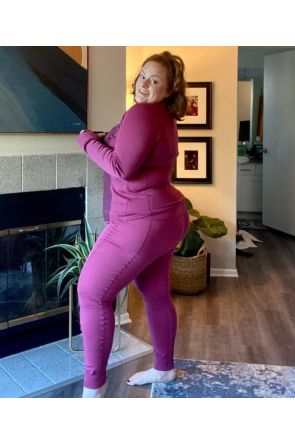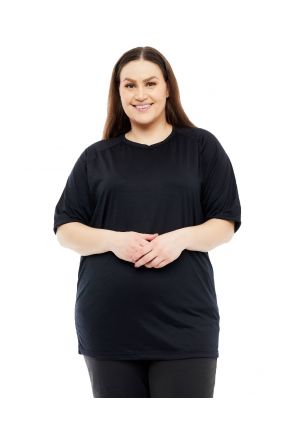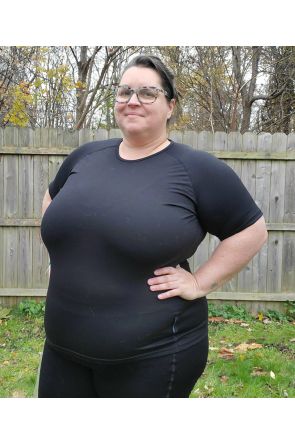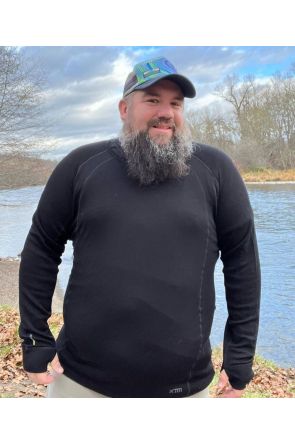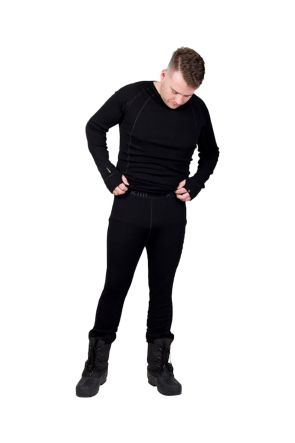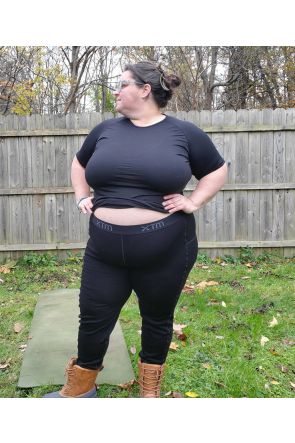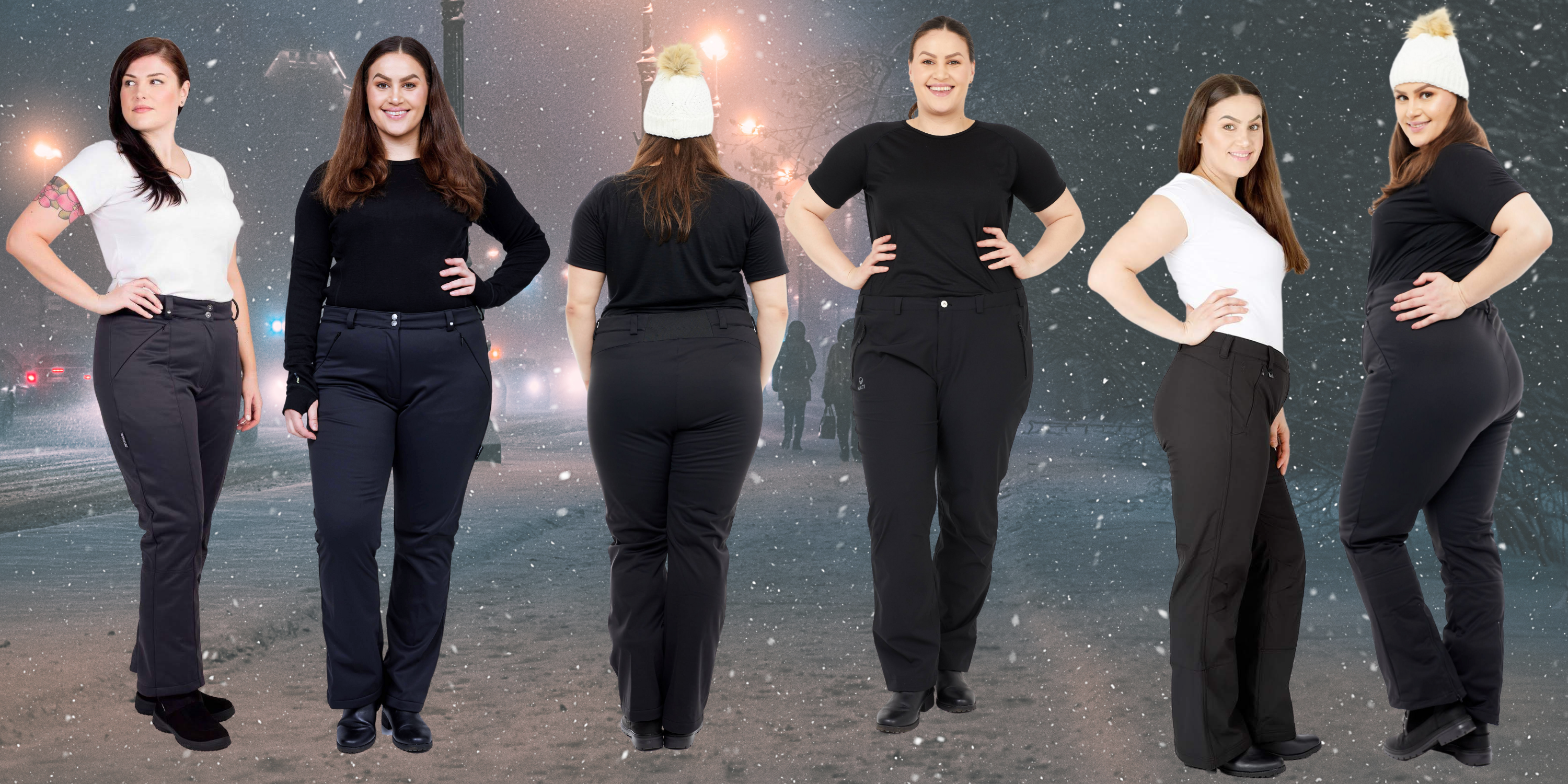What plus-size layers do I need to ski or snowboard?
Sometimes, a line from a great film tells us all we need to know about the human condition. Like this one: “Onions have layers. Ogres have layers. Onions have layers. Do you get it? We both have layers.” Deep.
You may not be an actual onion, or a green, cantankerous ogre, or live in a swamp with a donkey, but like Shrek, we all need layers. But figuring out what to take for a day in the snow can feel like mental gymnastics, especially if you’re new to skiing and snowboarding, or cold weather environments in general.
You definitely don’t want to be cold, but you’ll be moving around quite a lot, so you don’t want to be a puddle of sweat either. This bit’s actually important, because sweat freezes when it cools down, and that can be dangerous. You can read more about how layers can work together as a system by understanding the four main ways your body loses heat
Common layering mistakes we see include:
- Opting for a cotton t-shirt as a base layer.
- Wearing bulky clothing.
- Activewear worn too tight.
Why is it important to know how to correctly layer?
When we wear the right layers, they wick moisture away from our bodies, while trapping a small amount of air in and between each layer. The more layers you wear, the more air you’ll trap. Your natural body heat warms the air, acting as your own personal heater. Huh - physics!
If you’re plus-size, there can be an added layer (pun intended ;) ) of complexity, as plus-size ski gear has traditionally been poorer quality, which affects how the air escapes or is trapped in the layers, causing you to quickly become either too hot or too cold.
So, how do you find the Goldilocks level of comfort when you’re heading into a cold climate? Whether it’s a day on skis or travelling to see the Northern Lights, we’ve got your back.
Here are the plus-size layers you need to make winter your new favourite season, whether you’re skiing/boarding, travelling, or heading out for an urban adventure.
1. What Plus-Size BASE LAYERS do I Need?
Base Layers Should Wick Away Moisture to keep you dry
Should be snug and body-hugging
Your base layer is the clothing that sits closest to your skin, so it’s important that it’s both warm and comfy, as well as breathable, because you don’t want to feel like you’re wearing a plastic bag.
Technical layers (as opposed to just a cotton t-shirt and leggings) perform an important function. They are designed to wick moisture away from your skin. This is critical in an environment like many winter sports, where you can go from hot to cold very quickly. If you’ve worked up a bit of a sweat on the ski run, you don’t want that moisture next to your body when you’re sitting still on the chairlift or waiting in liftlines, because it will quickly cool down and you can become very cold. If you’ve ever sat around in a wet cotton t-shirt, you’ll know how long it takes to dry and how very uncomfortable it is.
Base layers (sometimes called thermals, thermal layers or long johns) tend to look like long pyjamas – and what could be cozier than wearing your PJs under your clothing?! Look for ones made of natural fibres like merino wool, which have moisture-wicking properties you need and will be both breathable and warm. Good plus-size base layers will also have flat or external seams, which means they won’t rub and chafe your skin.
Can I wear more than one set of thermal base layers?
Some people like to layer multiple thin base layers for colder days, but in general, most people find one set is enough even on quite cold days. If you’re really concerned about being cold, several thin, good quality base layers are always better than big, bulky layers. A hoodie or chunky knit might feel good on the street, but won’t trap the warm air like a base layer, and will feel heavy and uncomfortable underneath your jacket.
We love these XTM Adele thermal base layers for skiing, travel and cold-weather adventures. They’re so cute, and they come in sizes up to 26.
On the flip side, if you run hot, many of our plus size customers prefer a plus-size merino wool t-shirt as a base layer. The fabric will be warm and wick any moisture away, keeping you dry and comfortable without overheating. These versatile tops can also double as hiking and active sports clothing for all seasons, and typically can go longer without being washed than other fabrics.
With that said - base layers work best when they’re clean, so if you’re planning a longer trip into the cold, you may want to pack a few pairs of your favourite plus-size base layers, depending on the temperatures you’ll be expecting.
2. What is a MID LAYER and which ones do I need to stay warm in the snow?
Mid Layers Should Trap Body Heat
Mid-layers are the items of clothing that go on top of your base layers and underneath your outer layer. See, this stuff isn’t that complicated after all! Mid-layers are probably your most versatile option because you can change what you wear or even how many mid-layers you wear based on how cold the climate is and how much activity you expect to be doing.
Generally, for skiing and snowboarding (or other active winter pursuits), a fleece jacket or vest is a great choice, providing warmth and protection from the elements. It can be a good idea to choose a plus-size mid-layer with a higher collar to stop the cold air from going down the back of your neck. A top like the Boulder Gear Nola Fleece is great because it has a ¼ zip, keeping you toasty outside, but allowing you to unzip and cool off when you head inside for lunch or when you’re hitting the bar for après.
If you’re venturing into the snow for the first time, and you already own a thin, lightweight merino jumper (sweater, for our North American pals) this is a great choice to layer on top of your thermals. In the future, if you decide skiing is your jam and you want to go all-in, you may prefer to invest in a more technical mid-layer, but if you have something light and breathable already, this is a good place to save your beans. Just remember to steer clear of anything with cotton.
If you’re going somewhere very cold, or your outer jacket is a non-insulated shell, you should consider a second mid-layer in the form of an insulated jacket (like a puffer or puffy jacket), either down or a good quality synthetic insulation. Remember, if you’re skiing or boarding in a milder winter climate like Australia, New Zealand or coastal Canada, you may not need this additional layer because you’ll get quite warm through movement. But if you’re travelling to a very cold destination, or skiing somewhere that temperatures can be known for being brutally cold (e.g. the Canadian Rockies, Northern Europe), a warm and versatile jacket like the Stoy Louisa Plus Size Puffer can be the difference between the experience of a lifetime and huddling miserably in the lodge.
3. OUTER LAYERS - How to choose plus-size jackets and pants for snowy and cold weather
Should keep out the wind, rain, and snow, while allowing the hot air to escape (breathe)
Your outer layer, arguably the most important layer, is made up of the items that are going to protect you from the elements. That cold gust of wind, the damp snow that you definitely don’t want getting inside your pants. An outer layer for snow sports should be both waterproof and breathable, keeping you warm and dry on the chairlift but ensuring you can expel the warm air you create while you’re exercising.
Outer layers will usually have a rating from 8-30,000mm2 for their water repellency levels. Without going too technical on you, this describes how much water per square mm of fabric it will repel. For snow sports, we recommended looking at a minimum waterproof rating of 8,000mm2 and above and a breathability rating of 8,000gm/mm2 and above. You might also see these ratings referred to with a ‘K’, meaning thousand. For example, a jacket described as being 10k/10K means 10,000mm waterproofing and 10,000gm breathability.
Should I get insulated or shell outer layer?
Outer layers come in both shell and insulated designs, with insulated obviously being the warmest. The answer to whether a shell or insulated outer layer is best really depends on your chosen activities, where you plan to use them, and whether you naturally run quite hot or quite cold.
Shell (non-insulated) outer layers have been growing in popularity over the last few years. They tend to be the preferred choice of people who enjoy very active pursuits like backcountry skiing, and those looking to move fast and light. Those who run a bit hot also like the versatility of a shell outer layer. At this time, plus-size shell jackets and pants can still be hard to track down, but this is something we’re working on.
All that said, insulated ski jackets and pants are still the norms for the average skier and snowboarder who sticks to the resort boundaries. They’re also great for anyone spending extended time outdoors in the cold, particularly if there are periods where you’re not going to be moving as much (waiting for the perfect shot, building a snowman or sitting on a chairlift).
What to look for in plus-size insulated ski pants and jackets
Insulation levels, and quality of insulation, can vary a lot in outerwear. Unlike waterproof and breathability ratings, there isn’t a standard rating system.
Cheaper insulation tends to feel bulkier and will not be as warm for its weight. So that heavy-feeling Big Box Store jacket may in fact be a lot less warm than the light, the packable insulated jacket you find at a more technically-oriented store. So how do you know what to look for when it comes to insulation?
Generally, a down jacket or a synthetics brand name like Primaloft will be an indicator of better quality. Also, if your jacket or pants have a high waterproof and breathability rating, you can usually assume that better quality insulation is being used as well. In a plus-size ski jacket, you would expect an insulation level of roughly 40-60gm, whereas a long puffer jacket for travel might be 150-300gm.
Sidebar: If you’re considering a plus-size down jacket, look for ‘baffles’, which is like quilting, and will keep the down in place and prevent it from clumping in one spot. If your down jacket does settle, leaving cold spots, tossing it in the dryer with a tennis ball should bring it back to its original fluffed-up coziness.
What features should I look for in my plus-size outerwear?
Now you’re an expert in the technical aspects of plus-size outer layers that will keep you warm, there are just a few final features to know about.
To stay toasty, look for features like gaiters on the cuffs of pants and the waist of jackets (aka snow skirt, powder skirt, snow shield) which will both keep the snow out and the warmth in. If you’re travelling rather than skiing, a faux-fur trimmed hood will help to deflect any cold wind blasts coming towards your face, but we don’t love them for when you’re getting active in wet conditions, because the trim can get soggy.
If you’re travelling or doing other cold-weather activities like dog walking or photography, you might like the comfort and protection of plus-size soft-shell pants. These pants are a lot warmer than jeans and comfortable like leggings, but they are also usually waterproof and breathable to keep you super comfy when it’s wet and cold.
We know it can be tough to find good quality plus-size snow clothing, especially if you’re shopping online. Don’t worry, we’ve got you covered (ah, literally). Our shop your shape service takes the worry out of finding the perfect plus-size ski gear that will actually keep you warm and dry.
For more details, check out our guide on buying the right ski pants for plus size bodies. Jacket guide coming soon!
Accessorise, Darling
Last but definitely not least, you’ll want to think about the accessories you’ll need. We recommend:
- A good pair of insulated, waterproof, and breathable gloves or mittens (mittens are ALWAYS a lot warmer);
- A neck gaiter made from a soft, breathable material like merino wool or recycled fleece (if you’re skiing, you’ll definitely need this rather than a traditional scarf, which will come loose and fly around, creating an annoyance and a risk for you);
- Thin wool socks. For skiing and boarding, people commonly think that you need big thick socks for warmth, but actually, it’s the opposite. A pair of fine wool socks will ensure your feet can breathe and give you the best fit inside your boots.
- Helmets are an essential part of safety when spending the day skiing or snowboarding because head injuries don’t look good in any way, and they keep your head toasty warm.
- A big smile because you’re going out to have fun!
If you love absorbing every practical tip possible, check out these pearls of wisdom, like “if you start sweating, immediately shed layers or slow down”
What layers have you found to be your best friend for winter? Do you have questions about layering? Let us know - we love to hear about your experiences.







